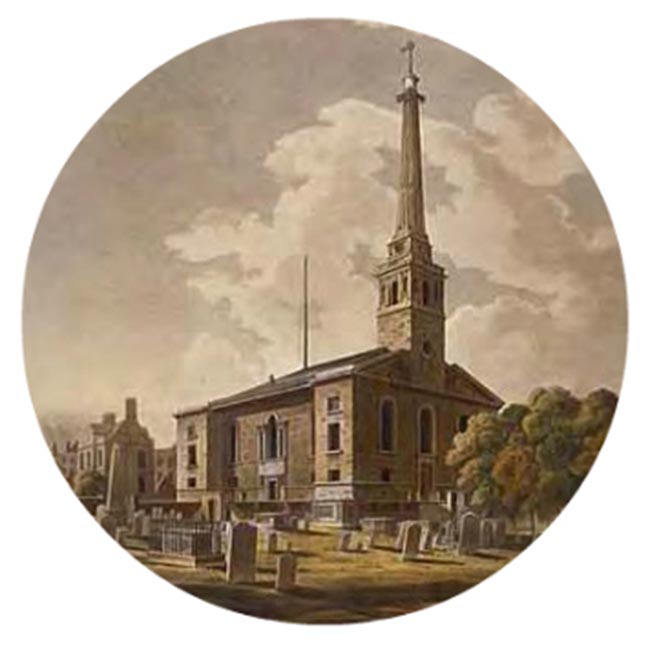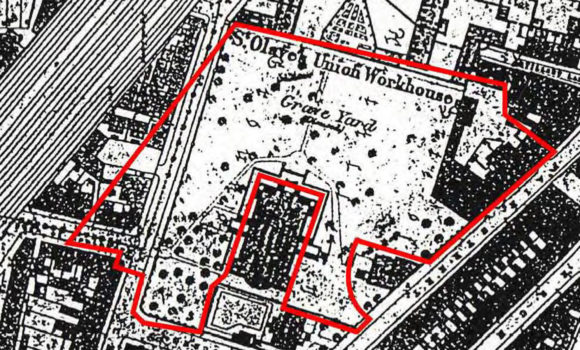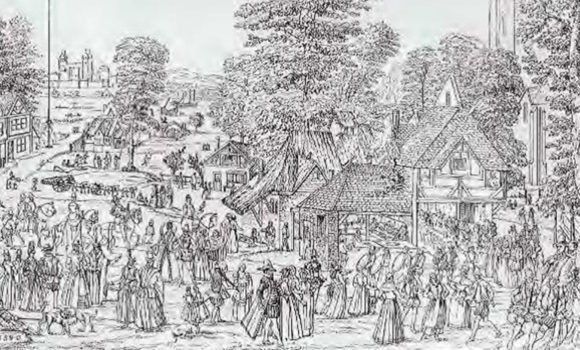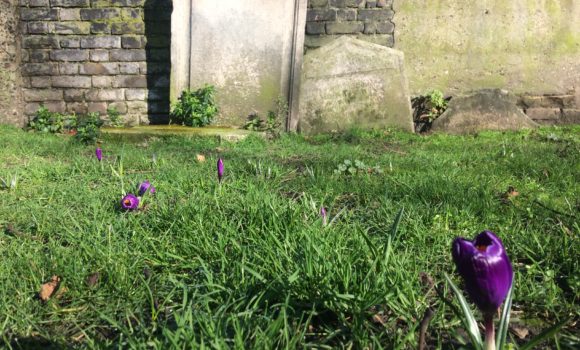Horselydown c. 1745 © Crown Copyright
History of St John’s Churchyard
St. John’s Churchyard has always been at the heart of the community. As a field for grazing horses, fairground, martial yard for militia men, burial ground and present-day open green space, the Park has always responded to the needs of its changing communities.
Early History – Horselydown
The early history of St. John’s Churchyard mirrors the evolution of London from a rural market economy to maritime trading power and industrial powerhouse. St. John’s Churchyard was originally known as ‘Horselydown’ – literally a field where horses lie down. The lush grassy area in the waterlogged fields close to the Thames was an ideal pasture area for trading men’s horses. The field’s proximity to a local ‘Tenter Ground’ also made it a useful resting spot for travelling cloth and linen traders.
As local business began to diversify as a result of trade via the Thames, the population grew. Industries flourished, encouraging people to live and work near the docks. By the middle of the 16th Century, some residential buildings had cropped up around the grassy area, and it became a green space for all to enjoy (including horses). In the late 16th Century, a local fair was held, and it is believed that this is how Fair Street derived its name. Fair Street still exists alongside the Park today.

Engraving of St. John Horselydown by John Buckler, 1800
Artwork by Gary Breeze
Industry and Armies
In the early 17th Century, an Artillery Hall was built to the west of the current site near St. John’s Church. A small piece of Horsleydown was enclosed and the land used as a Martial Yard for the Southwark Trainbands (a group of local militia men), who practised archery and exercised arms on the grounds. St. John’s Church was also granted the lease of the remaining land as a parish burial ground.
By 1725, more advanced weaponry had been developed due to the increased use of gunpowder, which made militia grounds redundant. The Artillery Hall was developed into a workhouse for the parish of St. John’s and the growing population needed a larger church and more facilities.
Renowned architect Nicholas Hawksmoor (who worked on St Paul’s Cathedral with Christopher Wren) designed the new church with John James in the late 1720s and St. John’s Horselydown, along with a parsonage and enclosure, were completed in 1733. The most distinctive feature of the church’s design was its unusual spire in the form of a tapering column, topped by a weather vane depicting a comet.
As well as the church, one of the first Christian workhouses was built by the churchwardens for ‘the poor of this Parish’. A reporter in 1789 mentions that the workhouse ‘now happily provided […] 50 poor Men and Women and 70 Boys and Girls, who are employed in spinning Mopp Yarn’. Industry was thriving in Bermondsey’s docks area and two local organisations, the Parish Church (St. John’s) and local school (St. Olave’s), worked together to support the community through the provision of education and faith.
Horselydown, c. 1875 ©Crown Copyright

Today
Since the 1970s, St John’s Churchyard has been re-developed into recreational space for the local community to enjoy, much like its first use in the 16th Century (except for the horses). In the early 2000s, the Park was landscaped by Southwark Council and a public artwork by artist Gary Breeze was commissioned. The work constitutes several historical passages, in a variety of fonts, inlaid in concrete throughout the park. When pieced together, it provides an interesting puzzle of the park’s history, encouraging visitors to explore the whole park.
St. John’s community roots are still central to the Park, which is surrounded by residential blocks. Potters Fields Park Management Trust is committed to providing a flourishing space for the local community since the Trust took over its management from Southwark Council in 2017. We are excited to play a part in St. John’s Churchyard’s rich history and look forward to embarking on further improvements and continuing the legacy of local use, recreation and enjoyment.
Horselydown, c.1590

World War II
St. John’s Churchyard and its neighbours remained largely untouched during the 19th Century, but the cemetery expanded as the population continued to grow. Generations of families had settled into industries and manufacture within the lucrative docklands area, and St. John’s Church was central to key life events – christenings, marriages and burials. Many marriage and death records from the St. John’s parish are now housed at the London Metropolitan Archives and can be viewed on request.
After the outbreak of World War II in 1939, London’s industrial hubs were a key target for aerial attacks; during The Blitz almost 25,000 bombs were dropped on London’s docks alone. Bermondsey’s landscape changed dramatically and many people who stayed in the area to help the war effort from home lost their lives protecting their communities.
By 1947, much of the church had been destroyed by bombs and was left almost derelict as the area began to rebuild after the war. By 1956 the church had closed, and the land transferred by the Churchwardens to the then Borough of Bermondsey. London City Mission bought the church’s site for redevelopment in 1974 and the plinth of the old Hawksmoor church can still be seen beneath London City Mission’s HQ.


